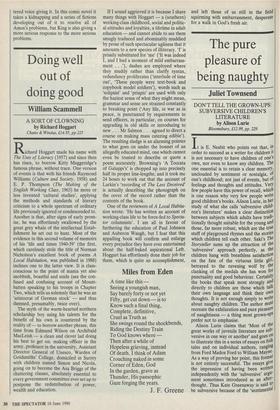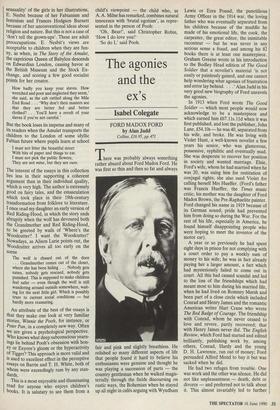The pure pleasure of being naughty
Juliet Townsend
DON'T TELL THE GROWN-UPS: SUBVERSIVE CHILDREN'S LITERATURE by Alison Lurie
Bloomsbury, f12.99, pp. 229
It is E. Nesbit who points out that, in order to succeed as a writer for children it is not necessary to have children of one's own, nor even to know any children. The one essential is to retain a clear memory, unclouded by sentiment or nostalgia, of one's childhood; not just of events, but of feelings and thoughts and attitudes. Very few people have this power of recall, which is one reason why very few people write good children's books. Alison Lurie, in her study of what she calls 'subversive child- ren's literature' makes a clear distinction between subjects which adults have tradi- tionally thought suitable for the young and those, far more robust, which are the true stuff of playground rhymes and the stories which children tell each other. Saki's The Storyteller sums up the attraction of the `subversive' approach perfectly, as the children hang with breathless satisfaction on the fate of the virtuous little girl, betrayed to the ravening wolf by the clanking of the medals she has won for punctuality and good behaviour. CertainlY the books that speak most strongly and directly to children are those which talk their own language and think their own thoughts. It is not enough simply to write about naughty children. The author must recreate the exhilaration and pure pleasure of naughtiness — a thing most grown-ups prefer not to emphasise. Alison Lurie claims that 'Most of the great works of juvenile literature are sub- versive in one way or another' and goes on to illustrate this in a series of essays on folk tales and on individual authors, ranging from Ford Madox Ford to William Mayne. As a way of proving her point, this format is not entirely successful. The essays give the impression of having been written independently with the 'subversive' argil' ment sometimes introduced as an after" thought. Thus Kate Greenaway is said to be subversive because of the 'sentimental sensuality' of the girls in her illustrations, E. Nesbit because of her Fabianism and feminism and Frances Hodgson Burnett because of her unconventional ideas about religion and nature. But this is not a case of `don't tell the grown-ups'. These are adult preoccupations. E. Nesbit's views are acceptable to children when they are fun- ny, as when, in The Story of the Amulet, the capricious Queen of Babylon descends on Edwardian London, causing havoc at the British Museum and the Stock Ex- change, and scoring a few good socialist points for her creator.
How badly you keep your slaves. How wretched and poor and neglected they seem,' she said, as the cab rattled along the Mile End Road . . . 'Why don't their masters see that they are better fed and better clothed? . . . You'll have a revolt of your slaves if you're not careful.'
But the book loses its impetus and many of its readers when the Amulet transports the children to the London of some idyllic Fabian future where pupils learn at school I must not litter the beautiful street With bits of paper and things to eat. I must not pick the public flowers, They are not mine, but they are ours.
The interest of the essays in this collection lies less in their supporting a coherent argument than in their individual quality, which is very high. The author is extremely good on fairy tales, and the emasculation which took place in their 19th-century transformation from folklore to literature. I once read my daughter an early version of Red Riding-Hood, in which the story ends abruptly when the wolf has devoured both the Grandmother and Red Riding-Hood, to be greeted by wails of 'Where's the Woodcutter? I want the Woodcutter!' Nowadays, as Alison Lurie points out, the Woodcutter arrives all too early on the scene
The wolf is chased out of the door . . Grandmother comes out of the closet, where she has been hiding . . . Nobody gets eaten, nobody gets rescued, nobody gets punished. This is supposed to make children feel safer — even though the wolf is still wandering around outside somewhere, wait- ing for the next little girl. Which is possibly truer to current social conditions — but hardly more reassuring.
An attribute of the best of the essays is that they make one look at very familiar stories, Winnie the Pooh, for instance, or Peter Pan, in a completely new way. Often we are given a psychological perspective. Who knows what deep subconscious yearn- ings lie behind Pooh's obsession with hon- ey or Eeyore's gloom or the hyperactivity of Tigger? This approach is more valid and is used to excellent effect in the perceptive essays on Barrie and T. H. White, both of whom were exceedingly rum by any stan- dards.
This is a most enjoyable and illuminating read for anyone who enjoys children's books. It is salutary to see them from a child's viewpoint — the child who, as A. A. Milne has remarked, combines natural innocence with 'brutal egotism', as repre- sented in the person of Pooh: `Oh, Bear!', said Christopher Robin, `How I do love you!'
`So do I,' said Pooh.



















































 Previous page
Previous page